Saturday, January 24th 2009

First AMD Benchmarks With DDR3 Memory Posted
Better late than never, AMD is embracing the DDR3 memory standard. Its newest desktop CPU socket, the AM3, connects the processor to dual-channel DDR3 memory. Initial specifications about AMD's processors on the new socket suggest that DDR3 1333MHz (PC3-10600) will be held as the memory standard the integrated memory controllers on AMD's processors support. The far-east team of Tom's Hardware posted the first series of benchmarks of a Phenom II AM3 processor, when paired with DDR3-1333. The benchmarks featured Gigabyte's MA790FXT-UD5P motherboard along with Corsair's dual-channel DDR3-1333 kit running at DRAM timings of 9-9-9-24. The CPU-Z window also shows that the memory modules are running unganged, meaning that the two memory controllers of the Deneb core are independent, with each controller handling a 64-bit wide memory channel. This state is somewhat comparable to that of single-channel memory, except that multi-threaded applications will still be able to independently address memory on each channel, utilizing all the bandwidth on offer.
At the center of the test-bench was the AMD Phenom II X4 910, the company's first flagship quad-core AM3 processor. The X4 910 features a default clock speed of 2.60 GHz. The same chip was tested in two settings: default clock-speeds, and overclocked to 3.12 GHz (240 x 13.0 @ default vCore). The screenshots below show the test results for WPrime. The overclocked chip scored a crunch-time of 46.613 s (1M). The overclock did not affect SuperPi at all, with insignificant differences in the scores between the two. PC Mark 05 got a decent boost, while 3DMark06 didn't. Memory bandwidth and latency tests showed something strange, with the overclocked CPU (in effect memory) turning up with lesser latency (while normally, increase in clock speeds tend to step up latencies). The tests show that there are increments in performance with the use of DDR3 memory, though they are merely proportional to the clock speeds the memory is running at.
Source:
Tom's Hardware
At the center of the test-bench was the AMD Phenom II X4 910, the company's first flagship quad-core AM3 processor. The X4 910 features a default clock speed of 2.60 GHz. The same chip was tested in two settings: default clock-speeds, and overclocked to 3.12 GHz (240 x 13.0 @ default vCore). The screenshots below show the test results for WPrime. The overclocked chip scored a crunch-time of 46.613 s (1M). The overclock did not affect SuperPi at all, with insignificant differences in the scores between the two. PC Mark 05 got a decent boost, while 3DMark06 didn't. Memory bandwidth and latency tests showed something strange, with the overclocked CPU (in effect memory) turning up with lesser latency (while normally, increase in clock speeds tend to step up latencies). The tests show that there are increments in performance with the use of DDR3 memory, though they are merely proportional to the clock speeds the memory is running at.
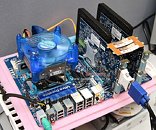
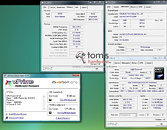
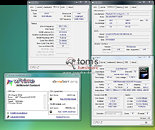

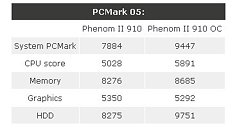
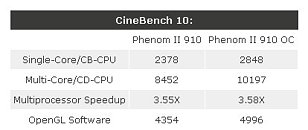
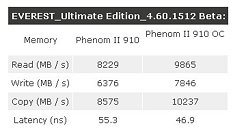
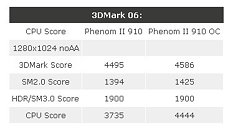
75 Comments on First AMD Benchmarks With DDR3 Memory Posted
For example, some people may want a super fast high end single core processor but Intel and AMD will be giving us Dual Core and Quad Core processors for these markets. Both companies will likely phase out even Dual Core,….
That’s life, just be thankful there isn’t a significant performance deficit in most cases with the new memory type,….. ;) Also be thankful that there is a choice between DDR2 and DDR3 for the Phenom II,….. Lord knows Core i7 users don’t have that choice :)
Granted we will still need to see a full review between DDR2 vs DDR3. But if I one was to get a AM3 setup regardless, this would be the route I would take if the ram can be used.
However, another question arises from this. If you are not able to get DDR3-1600 can you do CL5 or CL6 at or around DDR3-1400 (for example)? Time will tell either through reviews or through personal experiences.
I'm not going to go into it here, as there are more than enough threads running around TPU that discuss this little aspect; there's no need to get hung up on the high-timings of DDR3 when you stop to consider how much more information DDR3 moves per clock cycle compared to DDR2.
For example you can have 1066Mhz C6 with lower latency then 800Mhz C4.
But here, the fastest DDR3, and it's not released yet.GIGAshit? Lolz
At least, GIGA Boards don't need to boot from any kind of devices to update their board bios, (Press End when POST, and update your bios from FAT32 partition), and that isn't from Windows.
In the end, we will have to wait and see if they are able to actually get DDR3-1600 stable or not.
In regards to my setup, I saw little benefit in forcing CAS6 versus my current timings at the same clock speed (1800). So little, actually, I decided that it wasn't worth the risk of instability to shave fractions of a ns off latency benches.
Granted, this is with a X38 chipset - AMD's might be a completely different ballpark in regards to actual operational performance of DDR3 on their setups.
Everyone wants a DDR2 Vs DDR3 comparison using the exact same settings to actually see it it really does improve at all.
This p(r)eview shows performance scaling with an overclock that roughly sends the memory frequency to that of DDR3-1600.
A. Someone tests it for themselves and post results
B. A review is made available regarding the subject
In the end, what can be said without speculating is that if a lower latency doesn't hurt performance and proves to be stable there is no reason why one shouldn't.
While the amount of data moved in and out of memory with DDR3 is somewhat greater, remember that DDR3 was really motivated by large power reductions (claimed 30%) over DDR2, and less so for lower latency.
And everyone complained with DDR2 CAS numbers went from 1.5 or 2 all the way up to 7 when DDR2 was initially released. Somehow we survived that horrific event in human history :roll:
EDIT: OK, here is the explanation:
www.xtremesystems.org/forums/showpost.php?p=3600818&postcount=3
also with this comparison
DDR1 PC 3200 (400MTS) VS DDR2 PC2 6400 (800MTS)
both get work done at the same time, but it takes the PC2 to run at a slower latency and higher bandwidth to get it done aka
222 5 (DDR) vs 444 10 (DDR2) etc now if DDR was Upped to PC 6400 it would eat PC2 6400 alive.
But what I'm saying is that it should be able to produce better results despite this, because if you look at the price difference and how new the tech is you would expect it to be faster than a 2+ year old tech. It's the same as when DDR2 800 came out originally, the figures were similar to DDR 400 because of the latencies. The only thing going for it was the power consumption. That's only for the memory tests though.
But then if you look at Core 2 figures and Phenom figures in a superpi test the Core 2 is better even using the same RAM with the same latencies - so there is still scalability with respect to clock speed/computing power of the chip.
So I would expect the new chips to be better than the old one, even if they are using this "slower" memory.